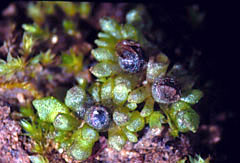Texas balloonwort facts for kids
Sphaerocarpos texanus, also known as the Texas balloonwort, is a small and interesting plant. It's a type of liverwort, which are simple plants that look a bit like mosses. You can find this unique plant in various parts of the world, including the Americas, northern Africa, and Europe.
Quick facts for kids Texas balloonwort |
|
|---|---|
 |
|
| Female plants of Sphaerocarpos texanus bearing mature sporophytes. | |
| Scientific classification | |
| Kingdom: | |
| Division: | |
| Class: |
Marchantiopsida
|
| Order: |
Sphaerocarpales
|
| Family: |
Sphaerocarpaceae
|
| Genus: |
Sphaerocarpos
|
| Species: |
S. texanus
|
| Binomial name | |
| Sphaerocarpos texanus |
|
| Synonyms | |
|
Sphaerocarpus berterii Aust., 1873 |
|
Contents
What is the Texas Balloonwort?
The Texas balloonwort is a small plant that grows flat on the ground. It has a simple body called a thallus, which means it doesn't have true stems, roots, or leaves like many other plants.
Plant Appearance
These plants are sexually dimorphic. This means the male and female plants look different in size.
- Male plants are usually small, about 3 to 5 millimeters across.
- Female plants can grow larger, up to 12 millimeters across.
Both male and female plants are bright green. Their thallus, or main body, can branch out several times.
Life Cycle
The Texas balloonwort is a winter annual. This means it starts growing in the autumn and then dies in the spring. It completes its entire life cycle within one year.
Unique Spores
A special feature of this plant is how its spores are formed. Spores are like tiny seeds that help the plant reproduce.
- The spores of S. texanus grow in groups of four, called tetrads.
- Unlike most other liverworts, these spores stay together in their tetrads until they start to grow into new plants.
Where Does It Live?
You can usually find the Texas balloonwort growing on flat ground. It prefers areas that are lightly shaded. A common place to spot them is along roadsides.
Where Can You Find It?
The Texas balloonwort has a very wide range. It's probably found in more places than any other species in its group. You can find it on several continents, including:

